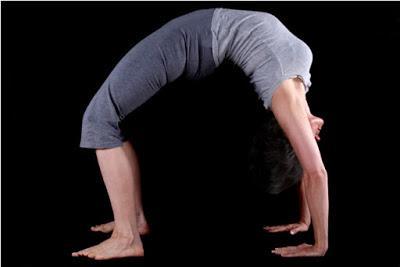
Terri Alexander, Age 55(Backbends can be uplifting for people with depression)
This morning I received an email from new reader in Japan who wants to introduce yoga for depression to the Japanese people and add the choice of yoga “in their pocket.” What an admirable goal! This has been one of my areas of interest for a long time because I feel yoga has so much to offer in the area of emotional wellbeing. So because I can’t teach this woman what I know in person and there is apparently no one teaching on this topic who lives in Japan (correct me if I’m wrong), I started thinking about how I could coach her a bit from a distance.I realized quite quickly that there were some basic things anyone needs to start by understanding before they can really study yoga for depression, and since I was going to write them down for her, I thought I should share them with you as well.
Learn about Yoga for Stress Management
I feel the first place to start is to learn about the functions of the autonomic nervous system and chronic stress. The reason for this is that stress is one of the things that can cause depression, and for people whose depression has other causes, being stressed can exacerbate the depression (and being depressed can cause you to stress out!). So it is important to understand what chronic stress does to your nervous system and how you can use yoga to help manage your basic stress levels. Personally, as someone who has suffered from two bouts of agitated depression, this knowledge has been extremely valuable, enabling me to keep myself healthy for the past two decades.
So start by learning about the autonomic nervous system in general by reading my post Life-Changer: Understanding Your Autonomic Nervous System. Then, after you’ve learned about the nervous system itself, learn about the difference between acute and chronic stress by reading my post About Stress: Acute vs. Chronic. Finally, learn about how to use yoga for stress management by reading The Relaxation Response and Yoga. And if you are not doing so already, try practicing yoga stress management techniques on a regular basis so you are really familiar with them and the differences between them. (This is because while stress management in general is beneficial for all, some techniques will work well for various people with depression while others may not. For example, Savasana with eyes closed can be very challenging for people with depression while a supported inverted pose with eyes open could work very well. And meditation may even be harmful—see Friday Q&A: Depression, Medication, and Meditation.)
Learn About the Types of Depression
Another very important subject area to study is the two types of depression, which are very different and need to be addressed differently with yoga. In my post Tamasic and Rajasic Depression, I discuss the differences between clinical depression (tamasic) and agitated depression (rajasic), and describe the different approaches you need to take for the two. Generally, because of the lethargic aspect of clinical depression, people with this form of depression need energizing as well as uplifting while because the anxious/agitated aspect of agitated depression, people with this form of depression need calming and soothing, rather than energizing. The more you understand about these two different forms of depression, the better you will be able to help someone (or yourself) who is suffering from one or the other.
Some other posts with information about yoga for depression that you might find useful include: Balancing Your Emotional Body with Counter-Poses and Balancing Your Emotions with Your Breath.
I also highly recommend reading the book The Noonday Demon: An Atlas of Depression by Andrew Solomon as a way to learn even more about the different types of depression. (Even though—bad Andrew—the only thing he says about yoga is snide and ignorant.)
Yoga is Not a Standalone Cure
Finally, always keep in mind that yoga is a supplementary treatment for depression, not a standalone cure. You can use it to help someone who is recovering from depression or to help someone who has once suffered from it to prevent its recurrence. But serious depression (as opposed to, say, just feeling mildly depressed about life) can be a life-threatening disease and someone with serious depression should be under professional care. While yoga teachers can work with someone who has serious depression, the teacher should always make sure the student is also seeing a trained professional. See Drawing a Line in the Sand: Where Yoga Teachers Should Not Go and No Shame, Please! (Western Medicine and Yoga are Complementary).
Subscribe to Yoga for Healthy Aging by Email ° Follow Yoga for Healthy Aging on Facebook ° Join this site with Google Friend Connect

